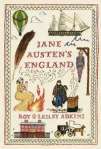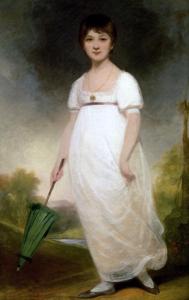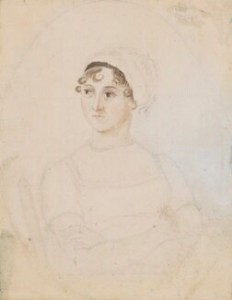Our April meeting topic was left deliberately ambiguous, enabling members to define it as they liked. What did a holiday mean in Austen’s times? What holidays occurred in the novels?
Beyond that, there were probably two main questions:
- how did Austen use holidays in her novels; and
- what do Austen’s novels tell us about holidaying in her time.
Holidays in Austen’s times
What is a holiday?
Two members grappled with this question. Dictionary definitions (using the Macquarie Dictionary, The Concise Oxford Dictionary, The Shorter Oxford Dictionary) include that a holiday is:
- a period of cessation from work ; or of recreation; a vacation OR A day of festivity or recreation, when no work is done; vacation
- a religious feast; a holy day OR a consecrated day; a religious festival
The Shorter Oxford Dictionary includes some earlier usages, including that a holiday is “a day to dance in and make mery at the Ale house” (1577), and “at home for thé holidays” (1806).
These meanings opened up a range of approaches members could take. One issue that we grappled with was whether a holiday could last just a day. The above definitions suggest it could.
Thinking Austen’s time, as one member noted, the previously popular Grand Tour became impossible once the war with France began in 1793, but journeys to view stately houses became common (as Austen clearly knew!) Another member found that excursions to the sea for two or three weeks were a novelty in Austen’s day. George III went to the sea at Sydmouth and Weymouth on his doctors’ order. The Prince Regent popularised Brighton by building the Brighton Pavilion.
Practical issues
Deidre Le Faye writes of the careful accuracy with which Austen planned her characters’ travel. She was particular about the relationship between towns, the distances and relevant times travel took. Going on holidays, however, depended on access to transport. Stagecoaches travelled at 8-10 mph, carriages or chaises drawn by one or two horses would travel at about 7 mph.
Pat Rogers notes that the prime means of getting around for people in Austen’s time was “on foot”, and there were those who went on walking holidays. Water transport, Rogers says, may have been used for trade and exploration, but not so much for travel. So, the most important factor affecting travel (and transport) in Austen’s time was the development of highways/roads. In the 17th century turnpikes were instituted to ensure that travellers contributed to the parish’s road maintenance costs. These toll gates are not mentioned by Austen as they would have been known to her readers and did not need explaining.
Rogers also notes that improvement in the roads made way for improvement in passenger vehicles – and could lead to such characters as “the travel bore” (like Northanger Abbey’s John Thorpe!)
Holidays in Austen’s novels
Religious holidays
One member started by asking whether people had holidays as we understand them in the late 18th/early 19th century? She looked at the religious holiday idea. The year may have been shaped by religious festivals, as surely clergyman daughter Austen’s was, but did this mean time off from work? Christmas is mentioned in some novels. Persuasion specifically talks about “Christmas holidays”.
In Pride and Prejudice, Easter is mentioned, as Laura Boyle discusses
Colonel Fitzwilliam’s manners were very much admired at the parsonage, and the ladies all felt that he must add considerably to the pleasure of their engagements at Rosings. It was some days, however, before they received any invitation thither, for while there were visitors in the house they could not be necessary; and it was not till Easter-day, almost a week after the gentlemen’s arrival, that they were honoured by such an attention, and then they were merely asked on leaving church to come there in the evening. (Chapter 31)
Boyle says:
There is not a lot of information about how the Austens celebrated the season. What little we do know is drawn from Jane’s letters and what was typical for the period. While it is assured that Jane Austen celebrated Easter, her holiday was probably a quiet one. She would have observed Lent and broken the “Fast” on Easter with a special dinner with her family. She may have dyed eggs and probably ate them in abundance once Lent was concluded. Mrs Austen is known to have had chickens at Chawton Cottage and it is unlikely that they would have allowed the eggs to spoil. Likewise, Austen mentions Lambs at Steventon, as well as Hams that her mother cured so either might have been eaten at Easter dinner. In her letters, she mentions using the Easter Holidays as a time to travel, and visiting friends along the way to one of her brothers’ houses. As a religious holiday celebrated by a religious family in the early 1800’s, it is unlikely that she ever associated the holiday with rabbits or candy.
Jane Austen’s World blog also discusses Easter, while Irene Collins, in her book, Jane Austen and the Clergy, writes that clergymen in Jane Austen’s day were not expected to write original sermons every Sunday, except on a few occasions, such as
“Henry Crawford, assessing Edmund Bertram’s commitments at Thornton Lacey, judged that ‘a sermon at Christmas and Easter ‘would be’ the sum total of the sacrifice.” (Mansfield Park, Ch. 23)
Collins also said that Mr. Collins produced only two sermons between his ordination at Easter and his visit to Longbourne in November of the same year. Elizabeth Bennet, she writes, is aware of Lady Catherine de Bourgh’s omission in not inviting the Collins’ and their guests in advance for this most important holiday, with the invitation (as quoted above) coming on the day.
Our member also shared Elizabeth Hawksley’s post about the clergy in Jane Austen’s novels. She describes Mr Collins during the days surrounding Easter, and his “far from busy” schedule:
So what did the vicar of a parish actually do? Elizabeth Bennet and Sir William and Maria Lucas visited the Collinses around Easter – today, the busiest time of the church year. Nevertheless, we hear of Mr Collins driving his father-in-law round the countryside every day during his visit, and of dinners at Rosings with Lady Catherine de Bourgh; but there is no mention of any church activities.
Holidays and plots
Other members, of course, looked at how holidays were used in Austen’s plots. A couple of members commented on the issue of length, noting that there are differences in meaning between holidays and visits. One proposed that in four of Austen’s novels, while the characters and scenes are markedly different, they are structured around both visits and holidays, where any number of incidents, both trivial and of great moment, occur to move the plots forward. She felt holidays or visitations away from home were not significant in Emma and Mansfield Park.
She argued that “holidays” or trips away represent a learning process for many the heroines – like Catherine Morland, Elizabeth Bennet, the Dashwood sisters. It is during these times that they begin to rely on their own sense of what is right rather than be guided by others. Many of the stories build from early incidents when visiting friends or family – including the near tragedy in Persuasion. She noted that coming home is also part of visits and holidays. In several novels, the heroines return to their homes moping and unhappy. That is until the heroes come riding to the rescue; each to claim his true love!
All members agreed that Austen did use holidays in her novels, and they play a significant role in driving her plots. One member went philosophical on us quoting Dietrich Bonhoeffer:
there is a meaning in every journey that is unknown to the traveller.
Meanings, she said, might emerge in the travels of Austen’s characters!
A few members discussed Pride and Prejudice, one suggesting, for example, that Netherfield in Pride and prejudice could be seen as a holiday home. We know where that led! Also, Lydia’s downfall comes from her going to Brighton for a holiday to stay with the Colonel and his wife. Wickham nearly had his way with Georgiana, when she was on holidays at Ramsgate with Mrs Younge. This member also wondered whether you could say Lydia and Wickham’s stay in London was a holiday in London?
Arguably though the most significant travels in Pride and Prejudice are Elizabeth’s. She re-meets Mr Darcy on her holiday to visit Charlotte at Hunsford Parsonage, and of course that connection is strengthened when she holidays in Derbyshire with the Gardiners.
One member quoted Austen on the trip to Hunsford:
Her fellow travellers the next day ….Sir William Lucas, and his daughter, Maria, a good humoured girl but as empty headed as himself, had nothing to say that could be worth hearing, and were listened to with about as much delight as the rattle of the chaise.
Both Elizabeth and Darcy learn much about each other during these two visits. As one member said, the stay at Hunsford provided opportunities for Elizabeth and Mr Darcy which would have been unlikely during daily life at Longbourn. This took the plot great leaps forward. Members noted Elizabeth’s becoming “absolutely ashamed of herself” on reading Darcy’s letter at Hunsford, because she had always prided herself on being a good judge of character. As one member put it, Elizabeth’s initial responses gradually unfold into semi-disbelief, perturbation, mortification at her belief of Wickham’s story. So, the six weeks at Hansford were a pivotal time in the life of some of the novel’s characters, particularly for Elizabeth who found so many of her strongly held ‘truths’ and prejudices to have been false.
The holiday nature of Gardiners’ planned trip, with Elizabeth, is also described by Austen (referencing, said our member, the picturesque, which we have discussed before):
tour of pleasure … oh, what hours of transport we shall spend … we will know where we have gone and what we have seen. Later, mountains and rivers shall not be jumbled together.
The actual journey takes them to the imaginary Lambton, near the (real) Bakewell, going through well-known tourist routes of the time (Oxford with its classical buildings, Blenheim Palace, Warwick Castle and the industrial town of Birmingham, and through rocky and wooded landscapes).
Once at Lambton, and visiting Pemberley, Elizabeth must reconsider her opinion of Mr Darcy, because it is there that she hears a glowing account of Darcy’s good qualities as a kind master and loved landlord, from the housekeeper. This increases her feelings that she may have misjudged him.
One member commented that it is when Jane is on holiday in London with the Gardiners, that she is rebuffed by Miss Bingley.
Finally, returning to the Netherfield holiday house concept, our member reminded us that it is when Mr Bingley and Mr Darcy visit the holiday home again that everything is resolved!
In Persuasion, Captain Wentworth is on holidays at Monkford with his brother when he meets Anne, and is on holidays with Admiral and Mrs Croft when he meets Anne again. When he hears that his friend Captain Harvill is living in nearby Lyme, a day outing is organised for everyone to visit Lyme, and here he has the opportunity to observe Anne’s marvellous capabilities when the fall occurs. Later, he goes on holidays to Shropshire with his brother to wait out Louise’s recovery and whether he is expected to marry her.
It is Lady Russell’s winter holiday in Bath, that brings Anne to that city, where she sees the Captain again. Harvill and the Musgroves visit Bath to buy wedding clothes, and the Crofts are there to treat the Admiral’s gout, giving Wentworth an opportunity with Anne.
Northanger Abbey begins with Mr and Mrs Allan inviting Catherine to join them on holiday in Bath, from where she is then invited to holiday at the Abbey. One member shared the blurb on the back cover of the Penguin Classics (1995) edition: “During an eventful season in Bath, Catherine meets the sophisticated Henry and Eleanor Tilney who invite her to stay at their mysterious house, Northanger Abbey. There Catherine runs into dangers, imaginary and real, and learns to tell the difference between books and real life, false friends and true.”
In Sense and Sensibility, Edward Ferrars holidays with the John Dashwood family where he meets Elinor. Willoughby meets Marianne while holidaying with his aunt at Allenham Court. Mrs Jennings invites Elinor and Marianne to holiday in London, where Marianne discovers Willoughby’s perfidy.
Holidays are less evident in Mansfield Park. Henry and Mary Crawford meet the Bertrams because they are on holidays with their sister, Mrs Grant. And Fanny is sent on holiday (?) to her family in Portsmouth when she refuses to marry Henry.
One member quoted Cronin and McMillan on Emma. Emma spends every night at home, and her longest journey is 7 miles to Box Hill:
…. the locality of Emma, the confinement of the whole novel to a few square miles of Surrey, allows Jane Austen to keep up throughout its length a dry commentary on the improbability, the extravagance and the conventionality of so many contemporary novels. …. It establishes Emma as a different kind of novel …… (and) began a novelistic tradition that culminated more than half a century later in George Eliot’s Middlemarch: a study of provincial life. (p. 47)
One member considered Sanditon, and the relationship between holidays and health, which is also referenced in Northanger Abbey regarding Bath. She suggested that Austen is chronicling Regency ideas about health and holidays, and wondered whether holidays were seen as something people did for health? In Sanditon, she suggested, Austen satirises the rise of “resorts” offering the health benefits of seabathing.
Austen, argued one member, uses holidays to move her female characters around.
The consensus was that people leaving their homes for other destinations drove Austen’s plots.
Jane Austen’s holiday romance
Another member looked at Austen’s own holiday-making. Family tradition says that in 1801 while on holiday in Sidmouth, a Devon seaside resort made famous by a visit from George 111 in 1791, Jane Austen fell in love. Sidmouth in 1801 offered the visitor a ballroom, a tea room and shops.
Little is known of the gentleman Austen met, neither his name nor his profession, although there is a suggestion he was a clergyman. We know that Cassandra mentioned him to her nieces and nephews years after Austen’s death.
He seems to have been handsome, intelligent and unusually charming. Cassandra praised him warmly. Caroline Austen said “I have never heard Aunt Cassandra speak of anyone else with such admiration.” By all accounts Jane was as smitten as he was but after 2/3 weeks together he had to leave. He was due to return and Cassandra had no doubt he would propose and be accepted. But tragically, he suddenly died, which his brother advised in a letter.
We know no more as none of Jane’s letters of the time survive. Either grief prevented her from writing or Cassandra destroyed them. However, David Cecil argues that the Sidmouth romance had a lasting impact on Austen. He believes that the reason Austen refused Bigg-Withers the next year was because “the flame of love for the Sidmouth gentleman was still so much a light that she could not help comparing her two suitors.”
Cecil references Austen’s advice to Fanny that nothing could exceed the misery of being bound to one while preferring another, and Anne Elliott’s statement (Persuasion) that women have a sad ability to go on loving when hope is gone. Cecil also believes that “the tone with which she writes of true love in her later books . . . is more tender and thoughtful than it is in the earlier”.
Sources
- Laura Boyle, Jane Austen’s Easter David Cecil, A Portrait of Jane Austen
- Irene Collins, Jane Austen and the Clergy
- Richard Cronin and Dorothy McMillan, “Emma stays at home”, Sensibilities 37, Dec. 2008
- Easter in Jane Austen’s day: A pastiche of information
- Elizabeth Hawksley, Jane Austen and the Clergy: How the System Worked, 16 August 2020
- Claudia Johnson, Jane Austen: Women, Politics and the Novel (1988)
- Deirdre Le Faye, Jane Austen: The World of Her Novels (2002)
- Pat Rogers, “Transport” in Janet Todd (Ed), Jane Austen in Context (2005)





 Posted by whisperinggums
Posted by whisperinggums 













